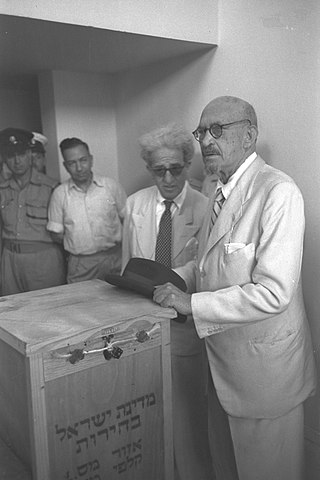
United Torah Judaism is a Haredi, religious conservative political alliance in Israel. The alliance, consisting of Agudat Yisrael and Degel HaTorah, was first formed in 1992, in order to maximize Ashkenazi Haredi representation in the Knesset. Despite the alliance splitting in 2004 over rabbinical differences, the parties reconciled in 2006, in order to prevent vote-wasting. In April 2019, the party achieved its highest number of seats ever, receiving eight seats.
The National Religious Party, commonly known in Israel by its Hebrew abbreviation Mafdal, was a political party in Israel representing the religious Zionist movement.
Mapai was a Labor Zionist and democratic socialist political party in Israel, and was the dominant force in Israeli politics until its merger into the modern-day Israeli Labor Party in January 1968. During Mapai's time in office, a wide range of progressive reforms were carried out, as characterised by the establishment of a welfare state, providing minimum income, security, and free access to housing subsidies and health and social services.

Agudat Yisrael is a Haredi Jewish political party in Israel. It began as a political party representing Haredi Jews in Poland, originating in the Agudath Israel movement in Upper Silesia. It later became the party of many Haredim in Israel. It was the umbrella party for many, though not all, Haredi Jews in Israel until the 1980s, as it had been during the British Mandate of Palestine.

Elections for the second Knesset were held in Israel on 30 July 1951. Voter turnout was 75.1%.
The United Religious Front was a political alliance of the four major religious parties in Israel, as well as the Union of Religious Independents, formed to contest the 1949 elections.

Hapoel HaMizrachi was a political party and settlement movement in Israel. It was one of the predecessors of the National Religious Party and the Jewish Home.
Poalei Agudat Yisrael was a trade union and Jewish political party in the Second Polish Republic and a minor political party in Israel. It was also known as PAI or PAGI, its Hebrew abbreviation.
Mizrachi was a political party in Israel, and is one of the ancestors of the modern-day National Religious Party–Religious Zionism.

Kalman Kahana was a long-serving Israeli politician and journalist, and a signatory of the Israeli declaration of independence. He was the brother of Yitzhak Kahan, a President of the Supreme Court of Israel.

The third government of Israel was formed by David Ben-Gurion on 8 October 1951, more than two months after the elections. His Mapai party formed a coalition with Mizrachi, Hapoel HaMizrachi, Agudat Yisrael, Poalei Agudat Yisrael and the three Israeli Arab parties, the Democratic List for Israeli Arabs, Progress and Work and Agriculture and Development. There were 15 ministers.

Haim-Moshe Shapira was a key Israeli politician in the early days of the state's existence. A signatory of Israel's declaration of independence, he served continuously as a minister from the country's foundation in 1948 until his death in 1970 apart from a brief spell in the late 1950s.

David-Zvi Pinkas was a Zionist activist and Israeli politician. A signatory of the Israeli declaration of independence, he was the country's third Minister of Transport.

Meir David Loewenstein was an Israeli politician and one of the signatories of the Israeli declaration of independence.

Mordechai Nurock was a Latvian-born Israeli who served in both the parliaments of Latvia and Israel. He was also Israel's first Minister of Postal Services, though he only held the post for less than two months.

The Assembly of Representatives was the elected parliamentary assembly of the Jewish community in Mandatory Palestine. It was established on 19 April 1920, and functioned until 13 February 1949, the day before the first Knesset, elected on 25 January, was sworn in. The Assembly met once a year to elect the executive body, the Jewish National Council, which was responsible for education, local government, welfare, security and defense. It also voted on the budgets proposed by the Jewish National Council and the Rabbinical Council.

Rabbi Avraham-Yehuda Goldrat was an Israeli journalist and politician who served as a member of the Knesset on behalf of the United Religious Front between 1949 and 1951.

Tova Sanhadray-Goldreich was an Israeli politician who served as a member of the Knesset for the National Religious Party between 1959 and 1974.
The first elections to the Assembly of Representatives in Mandatory Palestine were held amongst members of the Jewish community on 19 April 1920, except in Jerusalem where voting took place on 3 May. Ahdut HaAvoda led by David Ben-Gurion emerged as the largest party, winning 70 of the 314 seats.
Elections to the Assembly of Representatives of Mandatory Palestine were held on 5 January 1931. Mapai emerged as the largest party, winning 27 of the 71 seats.















